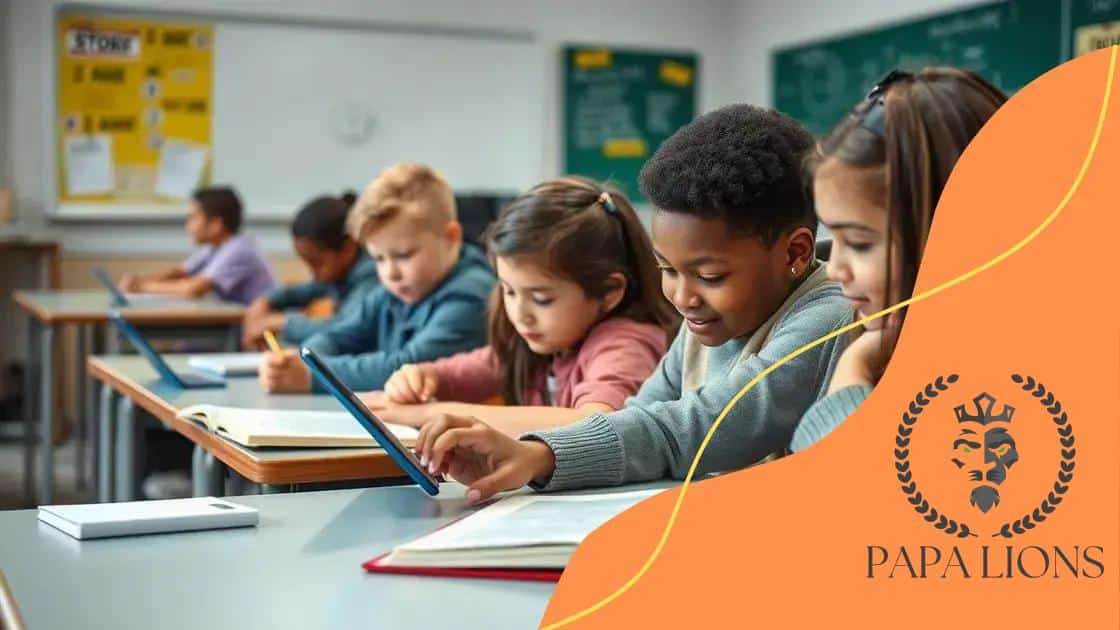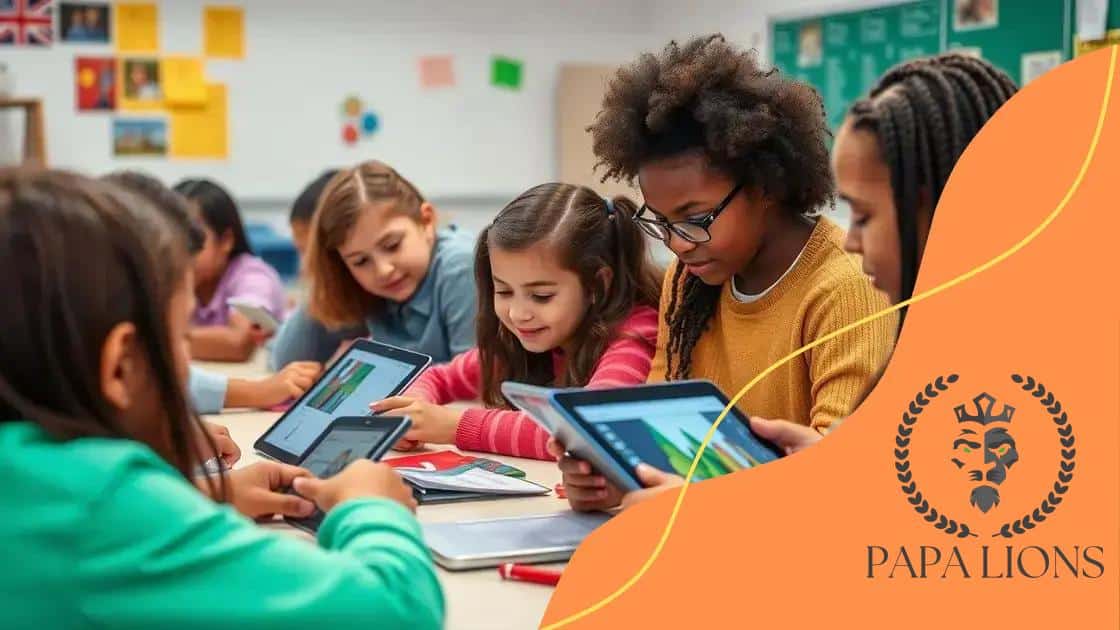Replacing books with tablets in class: The debate

Replacing books with tablets in class enhances student engagement, supports diverse learning styles, and offers personalized learning experiences, but presents challenges related to costs and accessibility.
Replacing books with tablets in class is a hot topic among educators and parents alike. Have you ever wondered if this shift truly benefits students? Let’s explore the implications together.
The advantages of using tablets in education
Using tablets in education comes with many advantages that can transform the learning experience. Students can access a wide range of resources instantly, making research and learning more engaging. This shift from traditional books to tablets is changing how knowledge is consumed and understood.
Enhanced Accessibility
One of the greatest benefits of tablets is their ability to provide learners with easy access to materials. With a tablet, students can:
- Download eBooks and educational apps
- Access online databases and resources
- Utilize interactive learning tools
- Connect with peers and educators through digital platforms
This level of accessibility allows students to personalize their learning experiences, catering to their individual needs and interests.
Interactive Learning Experiences
Another significant advantage is the interactive nature of tablet-based learning. Many educational apps and programs are designed to engage students actively. Instead of passively reading from a textbook, students become part of the learning process:
- Gamified learning experiences motivate and reinforce concepts
- Multimedia presentations appeal to different learning styles
- Real-time feedback helps students understand their progress
These elements create an environment where learning becomes fun and effective, pivoting away from traditional rote memorization strategies.
Additionally, tablets promote collaboration among students. Features such as shared documents or group projects enhance teamwork skills. Students can work together on assignments from different locations, fostering communication and cooperation.
Up-to-Date Information
By using tablets, students can access the most current information available. Unlike textbooks, which can quickly become outdated, a tablet allows learners to stay informed about the latest developments in various fields. This access to real-time information equips students with knowledge of current events and trends.
Overall, integrating tablets into education not only enhances accessibility but also cultivates a more dynamic learning environment. With their many benefits, tablets help shape the future of education by making learning engaging, interactive, and efficient.
Potential drawbacks of replacing traditional books
While there are many advantages to using tablets in education, it’s important to consider the potential drawbacks of replacing traditional books. Some challenges could affect students’ learning experiences and outcomes.
Distraction and Misuse
Tablets can be a source of distraction for students. With social media, games, and other apps available, it’s easy for a student to stray from their studies. This can hinder their focus and retention of information.
- Students may multitask and not fully engage with learning.
- Increased screen time can lead to fatigue and decreased attention spans.
- Poor time management skills may worsen when using tablets.
Therefore, it’s essential for educators to set clear guidelines on using tablets in classrooms.
Equity Issues
Another concern is the equity of access. Not all students have the same level of access to technology at home. This divide can impact their learning opportunities:
- Students without tablets may fall behind in assignments.
- Different levels of tech proficiency can create a gap among peers.
- Families may struggle with the costs associated with technology.
Schools need to address these issues to ensure that every student has equal opportunities to learn.
Furthermore, the reliance on technology can lead to a diminished ability to read print materials. As students engage more with tablets, there is a risk of developing less fluency with traditional texts. This could lead to challenges when they encounter print materials in the future.
Health Concerns
Using tablets for extended periods can also result in health issues. Eye strain, headaches, and poor posture are common complaints with excessive screen time. It’s crucial to promote healthy habits, such as regular breaks and ergonomic setups.
In summary, while replacing traditional books with tablets may offer significant benefits, the potential drawbacks must not be overlooked. Addressing these concerns can help create a more balanced and effective educational environment.
Impact on student engagement and learning styles

The shift to tablets in education significantly alters the impact on student engagement and the various learning styles students possess. These tools can provide interactive experiences that appeal to a broader range of learners.
Increased Engagement
Tablets often make learning more engaging by providing access to multimedia resources. Students can watch videos, listen to podcasts, and utilize educational games that capture their attention. This dynamic approach encourages active participation rather than passive absorption of information.
- Interactive elements can boost motivation and interest.
- Gamified learning helps solidify concepts through fun challenges.
- Digital tools allow for immediate feedback, enhancing student connection.
As students engage with the content, their interest in learning can flourish, leading to improved retention.
Diverse Learning Styles
Additionally, using tablets accommodates different learning styles. Some students are visual learners, while others excel through auditory or kinesthetic approaches. By incorporating various formats, tablets cater to:
- Visual learners with images, videos, and infographics.
- Auditory learners through podcasts and audiobooks.
- Kinaesthetic learners with interactive applications that involve hands-on activities.
This flexibility allows all students to connect with the material in a way that suits them best. For instance, a student struggling with text-heavy materials may find it easier to grasp concepts through an engaging educational app.
Moreover, tablets facilitate collaborative learning. Students can work together on projects, share resources, and communicate easily. This collaboration promotes a sense of community in the classroom, which can lead to enhanced motivation and the development of important social skills.
Understanding the impact on student engagement and learning styles is essential. The integration of tablets can lead to a more inclusive environment where all students have the opportunity to thrive.
Cost considerations for schools and families
When considering replacing traditional books with tablets, there are significant cost considerations for both schools and families. Understanding these financial aspects is essential for making informed decisions.
Initial Investment
Investing in tablets can require a substantial upfront cost. Schools must evaluate:
- The price of devices, typically ranging from $150 to $500 each.
- Costs for protective cases and accessories to ensure safety.
- Funding for software licenses and educational apps.
These initial expenses can strain budgets, especially for schools with limited funding. It’s crucial for districts to weigh the long-term benefits against the costs.
Maintenance and Updates
Beyond the initial costs, schools need to plan for ongoing maintenance. Tablets require regular updates and management, which can lead to additional expenses. This includes:
- Technical support for troubleshooting and repairs.
- Periodic updates for software and security enhancements.
- Replacement costs for damaged or outdated devices.
These ongoing costs can accumulate, making it important for schools to create a sustainable financial plan.
Families also face challenges. The cost of purchasing tablets or renting them can be a burden, particularly for low-income households. Some parents may struggle with the ongoing expenses associated with internet access or data plans.
Long-Term Savings
Despite the initial costs, tablets can lead to long-term savings. By reducing the need for printed materials, schools can potentially save money over time. Digital textbooks and resources are often less expensive than their printed counterparts.
Additionally, tablets can streamline communication and assignment submission, reducing paper costs and storage needs. This efficiency can result in an overall decrease in expenses.
In summary, while the cost considerations of transitioning to tablets are significant, they come with the potential for long-term savings and enhanced educational experiences. Schools and families must work together to address these financial aspects effectively.
Future trends in educational technology
The landscape of educational technology is always evolving. As we look to the future, several trends are emerging that will shape how students learn and teachers instruct. Technology is no longer just an accessory; it is becoming a central part of the learning journey.
Personalized Learning
One major trend is the movement towards personalized learning. This approach allows students to learn at their own pace and in their own style. With tablets and educational software, educators can tailor lessons to meet each student’s needs.
- Adaptive learning platforms adjust content based on student performance.
- Individualized lesson plans help target specific skills.
- Data analytics provide insights into student progress and areas for improvement.
This personalization can enhance engagement and improve educational outcomes.
Augmented and Virtual Reality
Another exciting trend is the use of augmented reality (AR) and virtual reality (VR)
This immersion has potential benefits for retaining information and fostering a deeper understanding of subjects. Additionally, the rise of AI (artificial intelligence) in education is transforming how students interact with learning materials. AI can provide real-time feedback and create customized learning paths. It also assists teachers by automating administrative tasks, allowing them more time to focus on teaching. The future will see continued growth in collaboration and communication tools. These platforms facilitate teamwork among students, whether they are working on projects or studying together. Features such as: These tools ensure that learning can happen anytime and anywhere, adapting to students’ schedules and lifestyles. As we look towards the future, it is clear that technological advancements will continue to influence education. By embracing these trends, schools can enhance learning experiences and prepare students for a tech-driven world. Tablets increase student engagement, provide access to diverse resources, and cater to different learning styles through interactive content. Schools may encounter high initial costs, ongoing maintenance expenses, and the challenge of ensuring equal access for all students. Technology allows for adaptive learning platforms that tailor educational materials to fit individual students’ pace and preferences. Expect the rise of AI, augmented reality, and personalized learning experiences that enhance engagement and improve educational outcomes.
Collaboration and Communication Tools
FAQ – Questions about replacing books with tablets in class
What are the primary advantages of using tablets in education?
What challenges do schools face when integrating tablets?
How can technology personalize learning for students?
What future trends should we expect in educational technology?





